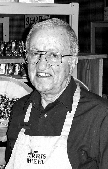 | The Farha’s, born and raised in Wichita, have spent their entire lives in the Food Business. Farris started in Farha Bros. Super Markets, then to F&E Wholesale Food Service, both family owned businesses. He spent 10 years with Pizza Hut (1969-1978) as V.P. of Administration and a member of the Executive Committee. A graduate of W.S.U., his only extended time away from Kansas was his military service in the Far East. Karen, too, was raised in the family food business, Cox Produce of Wichita. After Sterling College she managed the Dodge City division and eventually purchased that operation under the name of Cox Food Service. She later sold the company to F&E Food Service and assumed the position of Purchasing Manager and Executive Committee Member until F&E was acquired in 2005. In March of '06 the Farha’s opened The Farris Wheel, an old-fashioned candy, nut and gift shop. |
Candy, Chocolate & Sweets
2007-05-01 10:29:00
Chocolate and how it began
Question: I began thinking about why chocolate is so good. I felt your publication would be the best place to ask this question. Why do people crave chocolate, and where did the idea of chocolate begin?
Answer: You certainly hit upon a favorite subject of mine. I bet you won’t know the following answer without looking. What population in the United States consumes approximately 65 percent of all candy that is produced each year? I bet you said “children.” Wrong. It is U. S. adults who are 18 and over. I don’t know about you, but that statistic amazes me.
Now the next statement I imagine you can believe, chocolate candy sells 2 to 1 over all other kinds of candy. That’s why you and I crave chocolate. As to where it came from, history tells us that the Aztecs would prepare a hot, frothy drink from cacao beans and drink it because it would stimulate them to action and, also, had a restorative effect. It was used primarily by warriors, priests, and the nobility. The Aztecs actually felt it conferred wisdom and vitality. It was even used in sacred ceremonies. It is reported that Emperor Montezuma drank up to 50 goblets per day. Another interesting fact is the Aztec taxation policy. It was calculated in cacao beans. 100 of these beans would buy a slave. Cortez took the chocolate drink into Spain in 1529. There Spanish royalty feasted upon this treat for many years before the rest of Europe’s population began to consume it.
Three centuries later, or in 1847, people credit the birth of the very first edible chocolate bar. How it happened was that a man by the name of Joseph Fry experimented by mixing together some melted cacao butter with defatted cocoa powder and sugar and pressed this paste into a mold. It came out as edible chocolate. This resulted in people not only drinking chocolate but beginning to think of eating it. While many health-conscious people prefer dark chocolate, actually candy bars made with milk chocolate seem to be the favorite. To be considered a candy bar, a confection must be made with sugar, some type of flavoring, possibly a filling, and then created into a shape that is longer than it is wide.
Cadbury chocolate has been around since 1849 although their chocolate bars of today are totally different in taste than back then. People of today would think they were barely palatable because the early chocolate bars were made with bittersweet chocolate. In 1875 milk chocolate was invented when Henry Nestle who was known as a maker of evaporated milk got together with a man named Daniel Peter who was a chocolate maker. Then Rodolphe Lindt decided to add cocoa butter back to the chocolate and thus created a bar that would “snap” as well as melting on the tongue.
Hershey’s Milk Chocolate Bar followed soon thereafter. Actually World War I is credited with attention being brought to the candy bar. It seems that the U.S. Army instructed certain American chocolate candy manufacturers to send 20 to 40 pound chocolate blocks to overseas bases. The chocolate blocks were chopped into small pieces and passed out to the American Armed Forces. By the time the war was over and the forces returned as civilians, they had developed an attachment to chocolate and wanted more. Shortly thereafter chocolate manufacturers went back to making the smaller pieces. From then on throughout the 1920’s candy bar manufacturers became prominent in the United States. In fact, as many as 40,000 different candy bars appeared during that time. The Twenties actually became known as the high point decade of the candy bar industry. In fact, Reese’s Peanut Butter Cups, Butterfinger, and Milky Way all were invented in 1923. Between 1925 and 1938 favorites of Oh Henry, Mr. Goodbar, Snickers, 3 Musketeers, Kit Kat, and Nestle’s came into being. It is reported that many of the world’s oldest people had a passion for chocolate. Jeanne Calment was finally encouraged to give up chocolate sweets at 119, three years before she died at 122. Previous to that direction she ate two pounds of chocolate per week. Recently, there was a study of 8,000 male Harvard graduates done which showed that “chocoholics” actually lived longer than their counterpart “abstainers.” There is something in chocolate called polyphenols, and there is a theory that this protects against heart disease.
There are other studies being done which suggest that chocolate consumption may improve cognitive performance, verbal and visual memory scores, and impulse-control and reaction-time. These studies need far more substantiative data, and time will tell. Today, however, chocolates of every kind and taste are readily available over the counter everywhere. If history provides bases upon which to stand, let’s agree that chocolate gives more than a quick sugar rush. Chocolate is KING!


